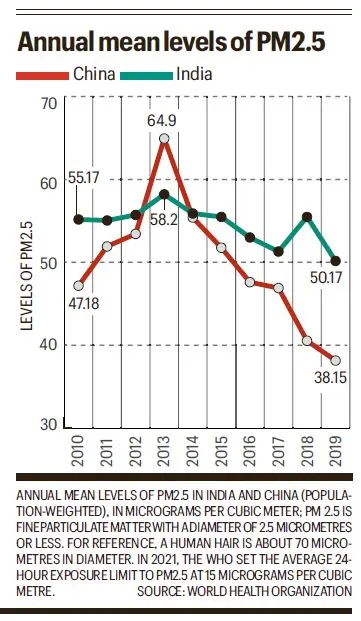



Copyright infringement not intended
Picture Courtesy: INDIAN EXPRESS
Context
India and China both suffer from severe air pollution due to industrialization, but their responses differ. China's centralized strategy has led to air quality improvements, while India's air quality has worsened.
|
Read all about: Air Pollution in India: Current Standards, Health Impact l Impact of Air Pollution on Child Growth and Development l Cloud Seeding for Delhi's Air Pollution |
Air Pollution in India
India faces a severe and persistent air pollution crisis, which escalates into a public health emergency each winter, particularly across the Indo-Gangetic plains.
While meteorological factors and seasonal events like stubble burning worsen winter smog, high pollution levels persist year-round due to systemic issues.
According to the World Air Quality Report 2024, India was ranked as the fifth most polluted country in the world.
 Key Drivers of Air Pollution in India
Key Drivers of Air Pollution in India
Vehicular Emissions: Growing number of private and commercial vehicles with inadequate emission control infrastructure.
Industrial Pollution: Emissions from power plants, heavy industries, and small-scale manufacturing units that often flout environmental norms.
Construction Dust: Unregulated construction and demolition activities contribute to Particulate Matter (PM) levels.
Stubble Burning: Seasonal agricultural crop residue burning in states like Punjab, Haryana, and Uttar Pradesh.
Household Pollution: Widespread use of biomass (wood, cow dung) for cooking and heating in rural and semi-urban households.
India's current air quality scenario is comparable to China's in the late 2000s, often termed 'airpocalypse' phase. However, through a determined and state-driven approach initiated in 2013, China has achieved improvements in air quality.
Strong Political Will & Accountability
The ‘cadre evaluation system’ was the key enforcement tool. By linking environmental performance, like air quality, to officials' career progression, this top-down pressure ensured strict local compliance with central government environmental directives.
Industrial and Energy Sector Reforms
Vehicular Emission Control & EV Push
Between 2013 and 2020, the average PM2.5 concentration across 74 major cities in China dropped by about 42%. (Source: forbes).
 What India can learn from China?
What India can learn from China?
Despite similar pollution, the nations' varied governance and policies have yielded distinct outcomes.
|
Parameter |
China |
India |
|
Governance Structure |
Unitary, top-down command-and-control system. Enables rapid and uniform policy implementation. |
Federal structure with overlapping jurisdictions between Centre, State, and local bodies, leading to challenges in coordinated action. |
|
Policy Approach |
Proactive, long-term national action plans with clear, time-bound targets and massive financial allocation. |
A mix of long-term plans like the National Clean Air Programme (NCAP) and reactive, emergency measures like the Graded Response Action Plan (GRAP) for the NCR. |
|
Accountability |
Strong and direct. The cadre evaluation system clearly links administrative careers to environmental outcomes. |
Diffused and often unclear. Accountability is rarely fixed on a specific institution or official for poor air quality. |
|
Unique Challenges |
Ensuring data integrity and balancing environmental goals with energy security (coal reliance). |
High contribution from the unorganized sector, household biomass burning, and balancing development with environmental protection. |
Create a Legally-Binding Mandate with Clear Accountability
India's non-binding NCAP targets a 40% reduction in PM by 2026 (from 2017 levels). It requires legal backing and a clear, China-like accountability mechanism for meeting these targets.
Adopt a Long-Term, Integrated Approach
Shift focus from reactive measures like GRAP to a continuous, year-round strategy that tackles pollution at its source across industrial, vehicular, and agricultural sectors.
Accelerate the Clean Fuel Transition
Though the Pradhan Mantri Ujjwala Yojana (PMUY) delivered over 10 crore LPG connections, sustained affordability and access to cleaner fuels are vital to fully eliminate household biomass burning.
Invest Aggressively in Green Public Transport
India should adopt China's successful strategy of electrifying public transport to reduce urban vehicular pollution, by expanding the FAME India Scheme to cover a greater number of city buses.
Strengthen the Monitoring Network
Expanding the network of real-time air quality monitoring stations beyond major cities is crucial for data-driven policymaking and enforcing compliance at the local level.
India can achieve rapid progress against air pollution by adopting China's core principles of ambitious, time-bound targets, strong accountability within its democratic framework, and strategic investment in clean technology and infrastructure through a hybrid approach combining top-down mandates with decentralized action.
Source: INDIAN EXPRESS
|
PRACTICE QUESTION Q. China's success in curbing air pollution involved technological and financial measures. Discuss how India can adapt them for its own context. 150 words |
While the strategy was multi-pronged, the most crucial factor was strong, top-down political will. The central government declared a "war against pollution," making it a national priority and, most importantly, integrated environmental performance into the promotion criteria for local government officials, ensuring strict accountability and implementation.
NCAP is India's flagship program, launched in 2019, to tackle air pollution. Its effectiveness is limited due to several factors: its targets are not legally binding on states, progress has been inconsistent, enforcement is weak, and fund utilization has been disproportionately focused on less impactful measures like road dust control instead of major sources like industrial and vehicular emissions.
An airshed is a geographic area where air quality is determined by a common mass of air. An airshed management approach involves creating and enforcing anti-pollution policies across this entire region, irrespective of state or city boundaries. This is crucial for India, especially for the vast and heavily polluted Indo-Gangetic Plain, as pollution from one state directly impacts the air quality of its neighbours.
© 2025 iasgyan. All right reserved